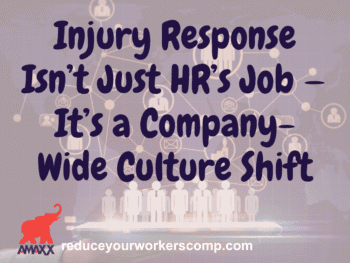A worldwide publishing business employing 30,000 employees in diverse positions (clerical, reporters, heavy-machine operators, and fleet drivers) was having little success containing workers’ compensation costs, which were rising every year.
The employer knew they were vulnerable to work comp claims. Back injuries, carpal tunnel syndrome, repetitive stress disorders, slips, trips, falls, and motor vehicle accidents were all common; machinery related accidents resulted in more serious and costly claims for amputation and broken or crushed limbs. Repetitive trauma claims were common among employees such as reporters using computers constantly. Professionals with repetitive trauma syndrome (RTS), fearful of losing their careers, often worked through pain, causing their injuries to become far worse than normal.
Goal Was To Put The Employer “In Charge Of” The Work Injury Process
The Risk Manager selected our team to help identify their main issues, develop solutions, and create a training program. The goal was to put the employer “in charge of” the work injury process. Once these changes were in place the employer noted improvements with the following:
- Adjusters learned the program and brokers gained more trust by showing them these resources.
- The company reported a 20% reduction in number of claims, and
- There was a 30% reduction in workers’ compensation losses in the first year, and in each ongoing year.
Here’s How They Did It!
After surveying their workers’ compensation management practices, the team discovered the company was strong in:
- Hiring Practices: Using background checks, drug testing, and reference checks.
- Medical Care Coordination: Employing a nurse at the on-site core facility to manage/document injuries; assist in drug testing.
However, they also identified three areas needing improvement:
- Communication with Employees. (Chapter 7)
- Reduce Repetitive Injuries. (Chapter 10)
- Direct Medical Care by improving penetration rate to company PPO network (Chapter 13)
The team began by assessing what was currently in place, they then compared their results to industry Best Practices and developed Plan for Action Improvement tailored for the employer’s workplace.
These areas were revised as described in Chapter 7: Communication with Employees.
- Weekly meetings were scheduled with injured employees. At these meetings, the focus was placed on the return-to-work aspect for the worker, especially setting up a target return-to-work date and assignment of a modified duty job.
- An experienced technical writer was hired to draft a brochure telling employees what to do when they feel pain — even the very slightest pain. The brochure described how an injury starts when they feel pain; it is then they need to start taking steps such as icing the wrists. Most importantly, they need to do simple exercises such as stretching, and take frequent breaks to avoid injury.
- Automated computer alerts reminded workers to take a break once an hour and workers were taught mild stretching exercises.
These areas were revised as described in Chapter 10: Wellness Programs
- The risk assessment team was surprised to learn that repetitive trauma claims (carpal tunnel syndrome and tendinitis) were common among employees such as reporters using computers constantly. Often, employees work through pain rather than seeking treatment immediately and actually end up worsening their condition, due to their job dedication.
- A wellness program was instituted to teach workers how to both avoid and treat repetitive trauma. An ergonomic specialist was called in to review the chairs and desks and to teach workers how to sit and what aids to use such as wrist supports at the keyboard, small bench under the feet to give correct alignment to the back, and use of light-weight hand “gloves.” Small packets of ice were kept in nearby refrigerators so employees could apply ice to the problematic areas of hands and wrists. They were taught that often the first symptom of carpal tunnel syndrome is pain at night, and that using wrist supports at night is helpful.
These areas were revised as described in Chapter 13: Directing Medical Care
- The employer started using their third-party administrator’s medical reviewer to review medical records on all claims to be sure the injured employee is being treated appropriately and returns to work as soon as medically able either to full duty or in a transitional duty position.
- A part-time Medical Director was hired for their on-site clinic to treat workers immediately and to track workplace safety. The Medical Director also makes referrals to other medical services as needed, and supervises the return-to-work process.
Our training manual discusses all of these techniques and suggests ways to bring workers’ compensation practices into line with industry best practices. 2014 Your Ultimate Guide to Mastering Workers’ Comp Costs: Reduce Costs 20% to 50% (Comprehensive Edition) discusses all of these techniques and suggests ways to bring workers’ compensation practices into line with industry best practices. Many forms and documents are available through Advisen at mbastone@Advisen.com.
Author Rebecca Shafer, JD, President of Amaxx Risk Solutions, Inc. is a national expert in the field of workers compensation. She is a writer, speaker, and publisher. Her expertise is working with employers to reduce workers compensation costs, and her clients include airlines, healthcare, printing/publishing, pharmaceuticals, retail, hospitality, and manufacturing. She is the author of the #1 selling book on cost containment, Workers Compensation Management Program: Reduce Costs 20% to 50%. Contact:RShafer@ReduceYourWorkersComp.com.
Editor Michael B. Stack, CPA, Principal, Amaxx Risk Solutions, Inc. is an expert in employer communication systems and part of the Amaxx team helping companies reduce their workers compensation costs by 20% to 50%. He is a writer, speaker, and website publisher. www.reduceyourworkerscomp.com. Contact: mstack@reduceyourworkerscomp.com.
©2014 Amaxx Risk Solutions, Inc. All rights reserved under International Copyright Law.
WORK COMP CALCULATOR: http://www.LowerWC.com/calculator.php
MODIFIED DUTY CALCULATOR: http://www.LowerWC.com/transitional-duty-cost-calculator.php
WC GROUP: http://www.linkedin.com/groups?homeNewMember=&gid=1922050/
SUBSCRIBE: Workers Comp Resource Center Newsletter
Do not use this information without independent verification. All state laws vary. You should consult with your insurance broker, attorney, or qualified professional.















